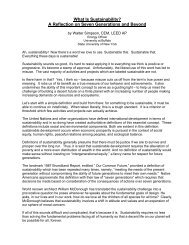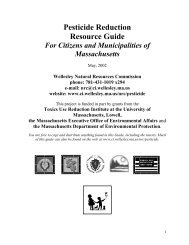Business Guide to Paper Reduction - Tufts Office of Sustainability
Business Guide to Paper Reduction - Tufts Office of Sustainability
Business Guide to Paper Reduction - Tufts Office of Sustainability
You also want an ePaper? Increase the reach of your titles
YUMPU automatically turns print PDFs into web optimized ePapers that Google loves.
Appendix A is a worksheet that can be used <strong>to</strong> start organizing information about paper use.<br />
Since every company is different, these are only guidelines <strong>to</strong> initiate an audit process. Below is<br />
an explanation <strong>of</strong> the questions in the worksheet:<br />
Questions <strong>to</strong> Ask in an Audit<br />
How is paper purchased throughout the company? Some companies have centralized<br />
procurement departments for multiple <strong>of</strong>fices, some have buyers for each branch, some<br />
purchase by department. Sometimes secretaries simply order when they see supplies are<br />
running low. The more centralized procurement is, the easier it will likely be <strong>to</strong> audit<br />
paper use. Understanding who makes what decisions in a company is the first step in<br />
understanding paper use.<br />
Whose approval is needed <strong>to</strong> change the paper for each commodity group? Each<br />
commodity group (i.e. the various uses <strong>of</strong> each type <strong>of</strong> paper, such as report printing,<br />
pho<strong>to</strong>copies, faxes, letterhead, etc.) may have a different set <strong>of</strong> people responsible for<br />
making purchasing decisions. Some paper purchasers may be empowered <strong>to</strong> make<br />
choices; others may need approval from the Board <strong>of</strong> Direc<strong>to</strong>rs. Marketing materials can<br />
have very precise requirements for their appearance, be highly specialized, and require<br />
sign-<strong>of</strong>f from numerous people <strong>to</strong> change them. Copy paper may not have as rigid<br />
appearance requirements but have specific performance requirements for each use.<br />
Tracking who needs <strong>to</strong> approve changes will help in organizing strategies <strong>to</strong> make<br />
changes in each commodity group.<br />
How much <strong>of</strong> each type <strong>of</strong> paper is purchased? A centralized procurement department<br />
may be able <strong>to</strong> measure purchase quantities for all commodity groups, whereas decentralized<br />
purchasing will likely require more effort <strong>to</strong> determine volumes. However,<br />
even centralized procurement departments may not have this information compiled in<br />
standardized units. This step may require gathering invoices, aggregating data, and<br />
converting it <strong>to</strong> a single unit that matches the reduction goals set in the company’s policy<br />
(i.e. weight versus volume).<br />
How much paper is used per commodity group? Each type <strong>of</strong> paper may be used for<br />
multiple purposes. Tracking how the paper is used within a company can help focus on<br />
where there are inefficiencies. Some procurement departments have well-developed<br />
systems for tracking how much <strong>of</strong> each type <strong>of</strong> paper is used for various purposes; others<br />
may only track what was purchased. The more centralized and organized the procurement<br />
department is, the easier it will be <strong>to</strong> benchmark how each type <strong>of</strong> paper is used. It may<br />
also be useful <strong>to</strong> track paper use from counters on machines such as pho<strong>to</strong>copiers, faxes,<br />
and printers.<br />
As each type <strong>of</strong> use is recorded, make notes on any obvious inefficiency or waste. For<br />
example, <strong>of</strong>ten companies find that a large amount <strong>of</strong> paper is used <strong>to</strong> print reports. Many<br />
<strong>of</strong> the reports are distributed, yet never read. By identifying the quantity <strong>of</strong> paper used for<br />
reports, it will be easier <strong>to</strong> determine ways <strong>to</strong> eliminate waste through eliminating<br />
unneeded reports, distributing them through print-on-demand only, or via the intranet.<br />
<strong>Business</strong> <strong>Guide</strong> <strong>to</strong> <strong>Paper</strong> <strong>Reduction</strong> 10







